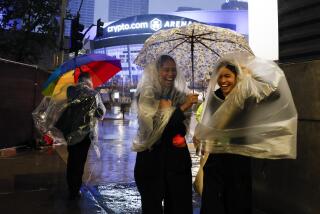THE DROUGHT : California Drought Watch
A monthly look at the water shortage
With the wet season two-thirds finished, the amount of snow and rain on California’s mountains continued to fall far short of normal. Statewide, precipitation is less than 1/4 of normal and is the lowest on record for this time of year, having dropped below that of the record-setting drought of 1977. The Sacramento River Basin, a main source of water for Southern California, has an all-time low precipitation level of 23% of average. This also remains the fifth unusually dry winter in the Eastern Sierra, another key Los Angeles source.
Coastal rainfall yardstick As of Feb. 21 A-- San Francisco: 40% of normal B-- Santa Barbara: 23% of normal C-- San Diego: 37% of normal D-- Santa Ana: 21% of normal E-- Ventura: 15% of normal F-- Los Angeles: 13% of normal
Sacramento River Basin Eastern Sierra Preciptation in normal season 33.9 inches 16.5 inches Preciptation this season 7.7 inches 4.2 inches Driest season on record 8.9 inches 4.6 inches (1977)
Colorado River
The Colorado River’s flow remains below normal, but California is still negotiating to tap the river to help relieve the drought. If six other Western states agree, Southern California will get more than its annual allotment of 4.4 million acre feet of water (*) to help it through this year.
* An acre-foot of water is the amount of water it would take to cover an acre with one footof water or 326,000 gallons.
The bottom line
Currently, runoff is averaging about 15% of normal and snowpack water content is less than 20% of average. Unless there is a strong turnaround in weather soon, the 1991 wet season could wind up as the driest in the 20th Century, with less runoff than in 1977. It all depends on the next 50 days.
The month the drought hit home.
If there were any drought-doubters still around in February, the level of official response to California’s stubborn dry spell was enough to dispel lingering skepticism. Here is a recap of the month’s events:
* State officials shut off water to farmers, and cut deliveries to cities by half.
* U.S. officials cut back water to farms by 75% and to urban areas by up to 50%.
* The Metropolitan Water District in Southern California reduced deliveries by 31%.
* A U.S. House subcommittee began investigating ways to reform California water management.
* Gov. Pete Wilson unveiled a five-point, $100 million plan hinged on creating a “water bank” for the future.
* The domino effect now in motion, Southern California agencies began implementing mandatory water rationing.
Water-saving tip:
“If there are any former sailors around they will perhaps know what a sea shower is. You get wet, turn the spigot off, you soap yourself down and when you’re ready to rinse you turn it back on again.”--Gov. Pete Wilson, himself a former Marine.
Viewpoint:
“It’s all just one big negative.” --Fred Starrh, 61, a Kern County farmer coping with losses from the drought.
DROUGHT FILE
Dead Trees: The drought has killed the equivalent of 8.4 billion board feet of lumber in California in 1989 and 1990--enough to build up to 500,000 new homes.
Cash for Grass: Marin County’s rebate program last summer paid 44 people about $245 each to rip out their lawns and install drought-resistant plants.
Help Wanted: The state’s Drought Center has had to move its offices and double its staff of four workers to handle the crisis. More openings are expected.
No More Hot Tubs?: San Francisco officials next week will consider cutting water for residents by 45%--meaning no more filling swimming pools and hot tubs.
Source: California Department of Water Resources, Santa Barbara Dept. of Water, Johnston Weather Watch, Los Angeles Dept. of Water and Power
More to Read
Sign up for Essential California
The most important California stories and recommendations in your inbox every morning.
You may occasionally receive promotional content from the Los Angeles Times.










